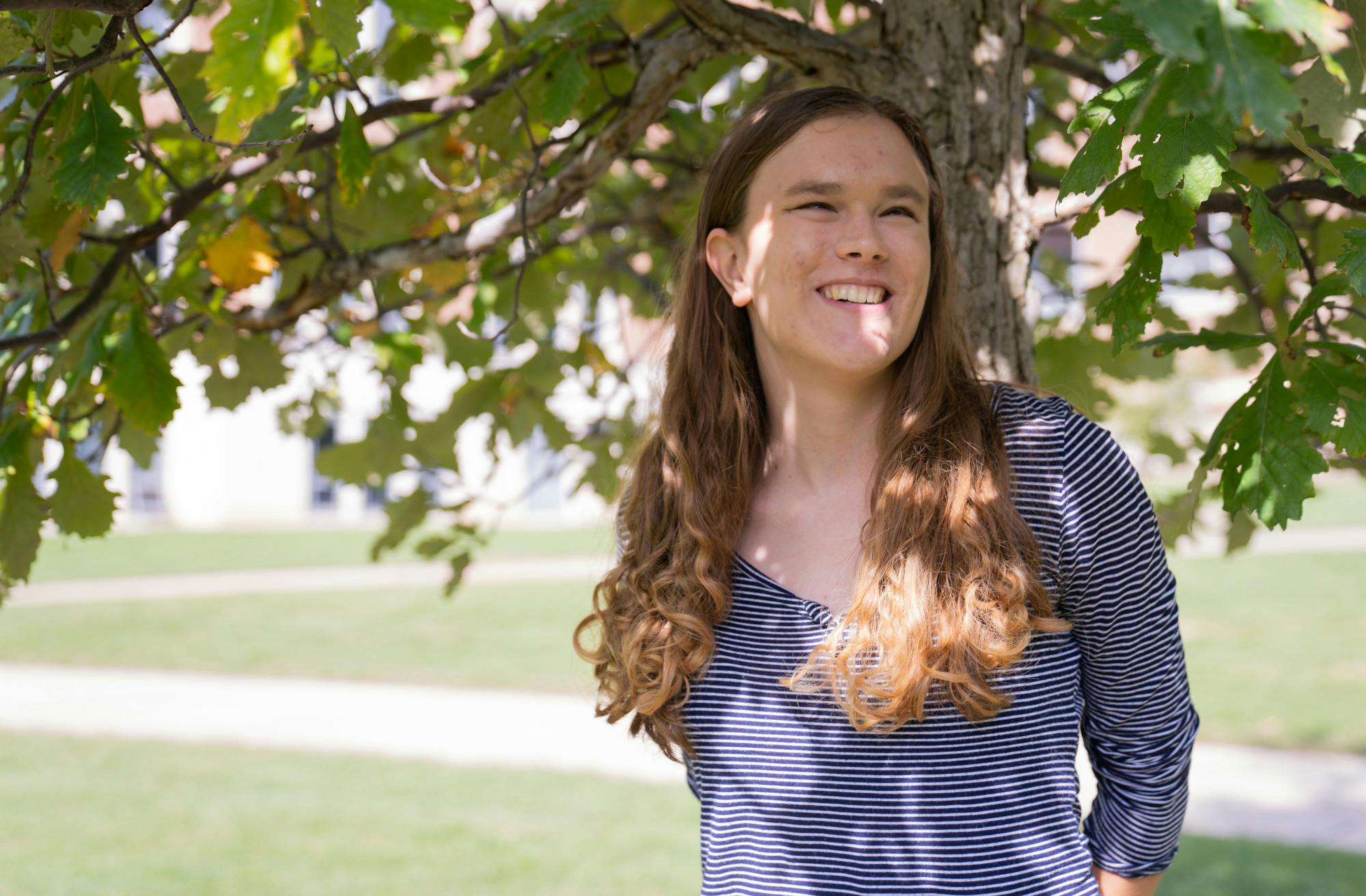October is Blindness Awareness Month: a month to bring recognition to the blind and visually impaired community.
Many people who are blind, however, don’t experience complete blindness. In fact, most forms of blindness is on a spectrum.

Social work senior Annika Arney stands in front of the MSU Union on Oct. 5, 2022. Arney said she hopes to go into school social work once she graduates.
October is Blindness Awareness Month: a month to bring recognition to the blind and visually impaired community.
Many people who are blind, however, don’t experience complete blindness. In fact, most forms of blindness is on a spectrum.
“It’s really different person to person,” social relations and English senior Alexandra Allers said. “So, I think it’s really cool that this is the time to acknowledge that and celebrate everything in the blindness community.”
Allers was born fully blind and, just at 10 months old, was diagnosed with Leber congenital amaurosis: a genetic disorder when the retina doesn’t fully develop.
The biggest challenge for Allers is a lack of understanding from people who haven’t encountered a blind person before.
“I really am just like an average student,” Allers said. “I do a lot of the same things that other students do — it just may be a slightly different way that I do it.”
Accessibility is important for people with disabilities to get around more conveniently; however, many believe that if a space is accessible for some, it’s accessible for everyone, Jeffrey Swada, director of the Undergraduate Food Science Program said.
Swada was born with vision but began seeing double at 10 years old due to a traditional cold that caused pseudotumor cerebri: a disorder when the body produces extra spinal fluid which squeezes the optic nerves.
As an undergraduate, Swada’s professors didn’t believe it was possible for him to go into the scientific field.
When Swada teaches or works in labs and researches, he is completely surrounded by visually centered individuals. However, with assistive technologies and accessibility techniques, Swada has found alternate ways to perform his career duties.
“Overcoming the obstacles and proving people wrong, showing them that once they actually saw what I can do, they say, ‘Oh yeah, that’s why he’s here,’” Swada said. “But there’s a lot of stereotypes to overcome to get to that point.”
Social work senior Annika Arney was born with retinopathy of prematurity. She is completely blind in her right eye and has some functional vision in her left.
Arney currently works at the Resource Center for Disabilities, or RCPD, and feels that they offer much more to students and employees with disabilities compared to other universities.
Accessibility was an important factor in choosing which university to attend.
“I actually always really wanted to come to MSU,” Arney said. “Overall, I’m happy with the accommodations that I’ve been given, and I feel happy with my choice to come here.”
RCPD has met all of Allers’ needs inside and outside of the classroom. During the school year, the center has helped Allers in receiving access to braille and electronic accessible text. Allers was also able to move into her dorm a few weeks before other students arrived to teach her guide dog the appropriate routes.
“Just overall, a lot of the people at MSU, the staff and the faculty have been really … great about asking about what I might need and then being willing to implement whatever accommodations I need,” Allers said.
Michael Hudson, director of RCPD, is now almost completely blind. He grew up believing he was “abnormal" and dreamed of being “normal” like his friends.
Hudson quickly discovered there were only two actions he could take: acquire skills to mitigate his blindness or psychologically adapt to it — the seemingly harder part.
“Everything we do seems to be based on looking and seeing and observing,” Hudson said. “That was torture. … it was not easy, and I think the antidotes for me were to start to meet some other people who were going through it or had already gone through it, so I wasn’t alone. You needed comradery or companionship on this journey, and you needed somebody to evidence that good things happen, even though your eyesight may not be intact.”
Support student media! Please consider donating to The State News and help fund the future of journalism.
Hudson is grateful for MSU’s large population, which makes connecting easier for students in the blind and visually impaired community. A tight-knit community is crucial, Hudson said. He encourages a call for partnership from both sides.
“I’m very independent, but in the end, it’s really helpful when people kind of understand your situation a little bit … to help you to be more connected and empowered in the community,” Hudson said. “I didn’t walk in thinking I was going to be blind someday, but it can happen to any of us. Life happens and being able to realize that there is a path forward under almost every tough situation.”
Arney hopes Blindness Awareness Month can break the stigma that brings low expectations of what the blind community can accomplish.
“It’s not too much different compared to anyone else's life,” Arney said. “We still have a normal life and should have normal expectations set for us.”
Acquiring skills and techniques to advocate is essential because you know your needs best, Allers said. Being open, having conversations about accommodations and getting involved with student organizations can boost the college experience for students in the blind community.
“You can do anything you put your mind to,” Swada said. “If it’s a hurdle you have to overcome it. You may have to try a little bit harder than somebody who doesn’t have a visual problem, but everybody has their own problems — whether they’re physical, mental. … if you just try you can succeed.”